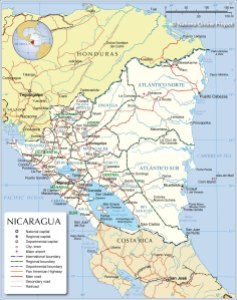For general information about the country profiles click here.
 Population: 5,991,733
Population: 5,991,733
HDI ranking: 129/187
HDI score: 0.599
After decades of political instability, Nicaragua entered into a period of economic growth, decentralized governance, and poverty reduction in the 2000s. However, in 2011 President Ortega defied the country’s constitution by remaining President for a third term. Municipal elections in 2012 were also marked by irregularities, though popular support for government administration remains high (NDI, 2013).
Local governance at a glance
- There is no ministry at the national level specifically mandated to perform decentralization. The Nicaraguan Institute for Municipal Strengthening (INIFOM) and the Office at the Technical Secretariat of the Presidency (OAP-SETEC) play a leading role (Development Partners, 2007).
- Nicaragua is divided into15 Departments and 2 autonomous regions: the North Atlantic Autonomous Region (RAAN) and the Autonomous Region of the Southern Atlantic (RAAS).
- Within the departments are 111 municipalities, each with a municipal council directly elected by the citizens.
Civil society actors include
- Hagamos Democracia (Let Democracy) promotes awareness and utilization of democratic values and initiatives in Nicaragua. Using an educational model, they aim to increase the direct participation of citizens and ensure the democratic processes of local authorities.
- Red Nicaragüense por la Democracia y el Desarrollo Local (The Nicaraguan Network for Local Democracy and Development) provides a space for communication between members of civil society committed to local democracy.
- Group FUNDEMOS is committed to facing the challenges of a democratic transition, and they strive to strengthen local democracy in Nicaragua municipalities through the development of an active civil society.
- Grupo ProJusticia (Group For Justice) promotes Nicaraguans’ understanding of the constitution and their rights established within the document regarding freedom of expression.
- The Institute of Strategic Studies and Public Policy (IEEPP) supports citizen participation in public affairs and aims to promote good governance. IEEPP works in both the civil society and state level to make decisions that work for both parties.
- The Nicaraguan Institute of Humanistic Studies (INEH) views development with a gender perspective; therefore, their work training and strengthening democratic authorities focuses on gender equality and overall autonomy.
Capacity building institutions
- The Nicaraguan Institute of Municipal Development (INIFOM) represents the interests of the municipalities as well as the federal government to strike a balance between the two and move decentralization forward.
- The Association of Municipalities of Nicaragua (AMUNIC) represents local governments statewide and played a key role in moving decentralization policies forward in the 1990s.
- The Federation of Central American (FEMICA) is a regional non-profit that assists with capacity building workshops for municipal leaders and other local authorities. FEMICA works heavily in Nicaragua, combining efforts with local capacity building organizations, such as AMUNIC, to promote autonomous local governance.
Fiscal control
- Local authorities must seek permission from the central government to introduce new taxes, and local taxes make up nearly half of the revenue on the local level (UCLG, 2010).
- The Law of Transfers (Ley de Tranferencias) came into effect in 2004 and mandates that 4 percent of state income be transferred to local municipalities. The law states that each year, the transfers will increase by one percent until they reached 10 percent in 2010 (UCLG, 2008).
Key initiatives for participatory local governance
- The 1997 Law on Municipalities mandates participatory budgeting practices and requires that mayors hold town meetings to make the local budgets public knowledge (ICMA, 2004).
- The 2003 Citizen Participation Law promotes participation through local departments and groups within municipalities (Hansen, 2007).
- In 2006, the government initiated the National Policy of Decentralization, laying out the steps necessary to implement decentralization in the country (UCLG, 2008).
- According to UCLG, the sewage, lighting, and solid waste sectors of government are all decentralized (UCLG, 2008).
Challenges for participatory local governance
- There is no democratic representation below the level of the municipalities, so popular elections do not take place on the most local scale (UCLG, 2008).
- The sectors of local government considered to remain the most centralized are public safety, education and health (UCLG, 2008).
Recent posts on this website about this country:
- Local Governance Assessments (2014)
- Decentralisation and devolution in Nicaragua’s north Atlantic autonomous region : natural resources and indigenous peoples’ rights (2012)
- A video report from the Competing for water programme on local conflict and cooperation over water (2010)
- Results of the innovation plans contest from the learning path (2010)
- Tenure rights and beyond : community access to forest resources in Latin America (2008)
- Alignment strategies in the field of decentralisation and local governance : a review of country practices and experiences : Nicaragua : international development partner harmonisation for enhanced aid effectiveness (2007)
- Alignment strategies in the field of decentralisation and local governance : a review of country practices and experiences : international development partner harmonisation for enhanced aid effectiveness : final main report (2007)
- Recentralizing while decentralizing : how national governments reappropriate forest resources (2006)
- Women and local democracy : lessons from Central America (2005)
- Participation and decentralized forest management : social effects of local government initiatives (2004)
______________________
List of sources (in order of citation):
UN Human Development Index, 2012: “Nicaragua”
NDI, 2013: “Nicaragua”
Development Partners, 2007: “Development Partners Working Group on Local Governance and Decentralization: Alignment Strategies in the Field of Decentralization and Local Governance, A Review of Country Practices and Experiences, Nicaragua”
UCLG, 2008: “Nicaragua”
UCLG, 2010: “Gold Report”
Hansen, F. International Development Partner Harmonization for Enhanced Aid Effectiveness, 2007: “A Review of Country Practices and Experiences: Nicaragua”
ICMA, 2004: “Nicaragua Country Report”
